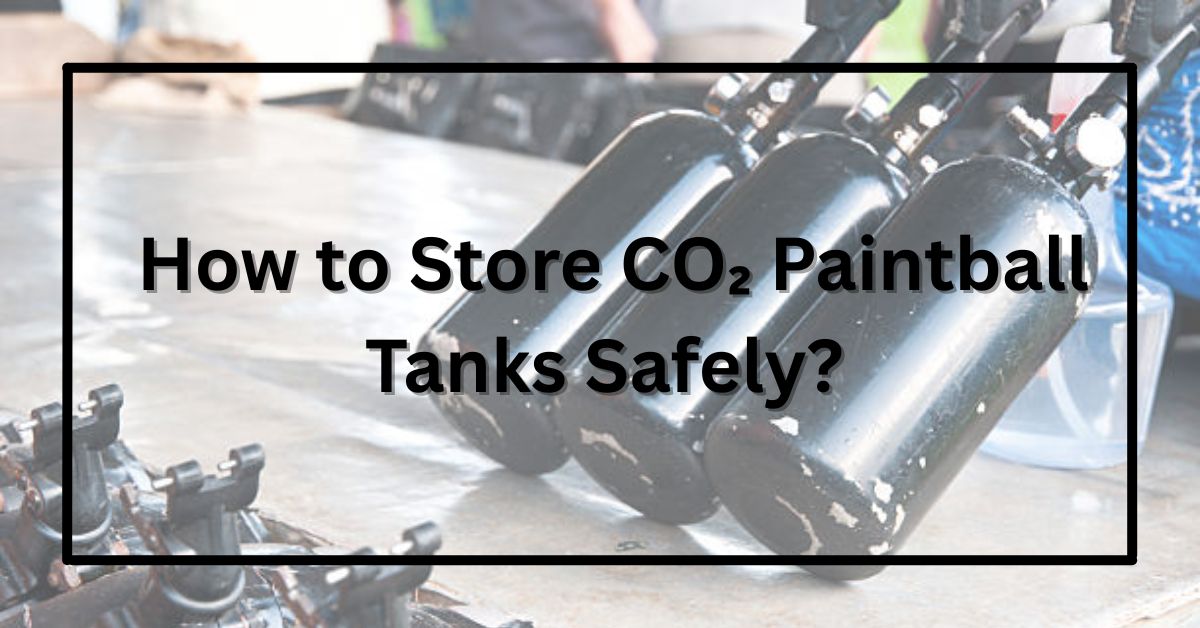Your paintball CO₂ tank is one of the most essential—and potentially dangerous—pieces of equipment you own. These tanks are filled with pressurized gas that powers your marker, but when stored incorrectly, they can become unstable or even hazardous.
Whether you play every weekend or just a few times a year, proper CO₂ tank storage is critical to your safety, tank lifespan, and performance on the field. In this guide, you’ll learn exactly how to store CO₂ paintball tanks safely and keep them in perfect working condition year-round.
Why Proper CO₂ Tank Storage Matters?
Storing your CO₂ paintball tank safely isn’t just about protecting your investment, but it’s also about preventing dangerous pressure-related accidents. Improper storage can cause:
- Pressure buildup if exposed to high temperatures
- Leaking or burst discs from overexpansion
- Rust or corrosion may occur if stored in damp conditions
- O-ring damage or weakened seals over time
By following safe storage practices, you’ll avoid costly replacements and ensure your tank performs reliably every time you play.
Understanding CO₂ Paintball Tanks
First, let’s discuss what distinguishes CO₂ tanks from other storage options.
CO₂ tanks contain liquid CO₂ at high pressure. When expelled, this liquid transforms into gas, which powers your marking.
They differ from HPA (high-pressure air) tanks, which use compressed air and are less affected by temperature changes. Because CO₂ is temperature-sensitive, storage conditions play a much bigger role in safety and performance.
Most paintball CO₂ tanks are made of aluminum or steel, which are durable but still susceptible to rust and heat damage if neglected.
Safety Risks of Improper CO₂ Tank Storage
CO₂ expands as it heats up, which means storing your tank in the wrong environment can lead to dangerous pressure spikes.
Common problems include:
- Burst discs are blowing out due to heat exposure
- Leaks around the valve or O-rings from wear and drying
- Corrosion or pitting caused by humidity
- Loss of performance if the tank’s internal pressure fluctuates
These risks are easy to avoid with a few simple safety steps.
Ideal Conditions for Storing CO₂ Tanks
To keep your CO₂ tank safe and ready for your next game, follow these guidelines:
- Temperature: Store between 50°F and 75°F (10°C and 24°C).
- Humidity: Keep in a cool, dry, and shaded area
- Sunlight: Avoid direct sunlight and hot car interiors
- Position: Store vertically to protect the valve and regulator
- Environment: Keep away from heaters, stoves, or open flames
Pro Tip: If you wouldn’t leave a soda can in that spot, don’t store your CO₂ tank there either.
Step-by-Step: How to Store CO₂ Paintball Tanks Safely
Step 1: Inspect the Tank
- Check for dents, rust, or cracks on the body. Examine O-rings and valves for leaks or damage.
- If you notice hissing sounds, frost buildup, or corrosion, get your tank serviced before storing it.
Step 2: Partially Empty the Tank (for Long-Term Storage)
- If you’re not using the tank for several months, release a small amount of pressure to reduce internal stress.
- Do not empty it—leaving a bit of gas inside prevents moisture from entering.
Step 3: Detach the Tank from the Marker
- Always remove your tank from your paintball gun before storage. Leaving it attached can damage the ASA or cause leaks.
- Seal the valve with a tank plug or cap to keep dirt out.
Step 4: Store Upright and Secure
- Keep the tank standing upright in a stable position to protect the valve assembly.
- You can use a tank stand or rack to prevent tipping.
- Avoid laying the tank on its side for long periods—this can stress the valve.
Step 5: Keep in a Safe Environment
- Store indoors in a temperature-controlled room away from sunlight, heat, and humidity.
- Avoid garages or sheds where temperature and moisture fluctuate.
- Use a padded carrying case or wrap the tank in a soft cloth for extra protection.
Seasonal and Long-Term Storage Tips
If you’re storing your CO₂ tank for winter or off-season:
- Store indoors where the temperature stays consistent
- Check O-rings and replace them every few months
- Keep away from freezing or boiling environments
- Cover with a cloth or case to block dust
- Get your tank hydro-tested every 5 years to ensure it’s safe
Hydro-testing is mandatory for all CO₂ tanks and ensures the cylinder can safely handle pressure.
What Not to Do When Storing CO₂ Tanks
To avoid accidents or premature damage, remember:
- Don’t store in direct sunlight or hot vehicles
- Don’t expose to flames, stoves, or heaters
- Don’t leave tanks fully pressurized for long periods
- Don’t drop, dent, or roll the tank
- Don’t keep tanks connected to your paintball gun
Transport and Handling Tips
When moving or transporting your CO₂ tanks:
- Always use protective caps to cover valves
- Keep tanks upright and secured in your vehicle
- Avoid tossing or rolling tanks around
- Inform others handling your gear that it contains pressurized CO₂
Safe handling during transport prevents valve damage and potential leaks.
When to Replace or Service Your CO₂ Tank?
Even the best-maintained tanks wear out eventually.
Replace or service your CO₂ tank if:
- The hydro-test date (stamped on the tank) is over 5 years old
- You notice deep dents, corrosion, or leaks
- The valve or burst disc shows visible damage
- The tank fails to maintain pressure during use
Never attempt to repair a damaged tank yourself—always take it to a certified paintball airsmith or shop.
Conclusion:
Proper CO₂ tank storage is simple, but it’s also one of the most important safety habits every paintball player should follow.
By storing your tanks in a cool, dry, upright position and checking for damage regularly, you’ll extend their lifespan, maintain safety, and ensure reliable performance every game.
Treat your CO₂ tank with care—it’s not just a piece of gear; it’s a pressurized powerhouse that fuels your fun.

